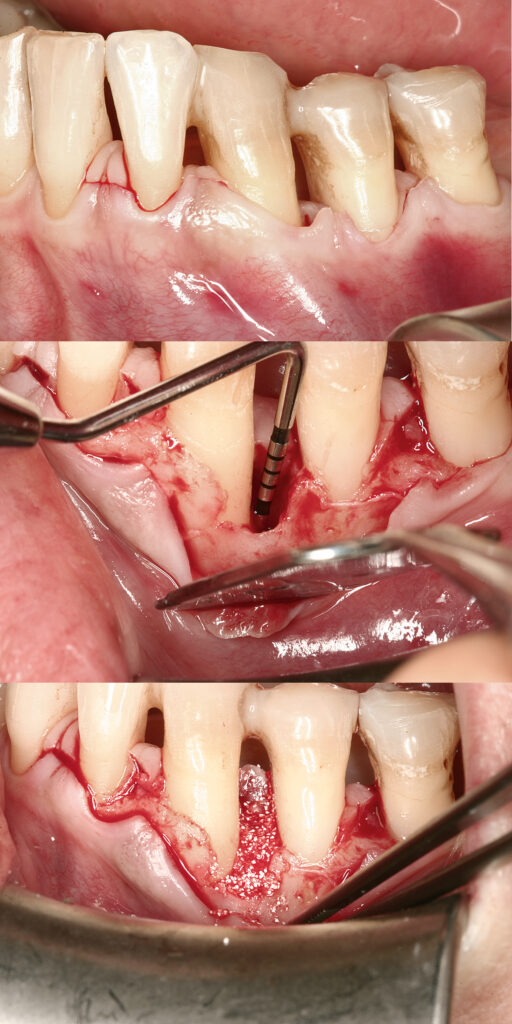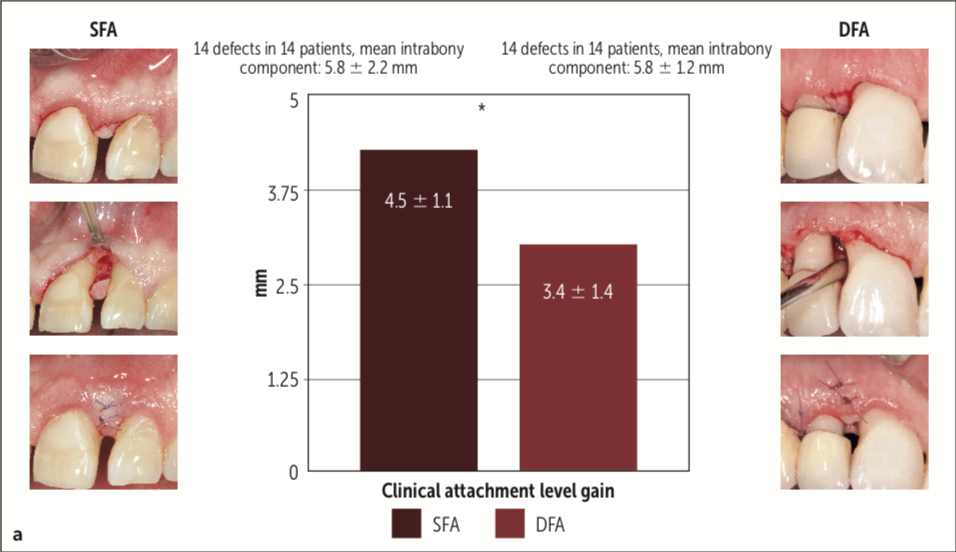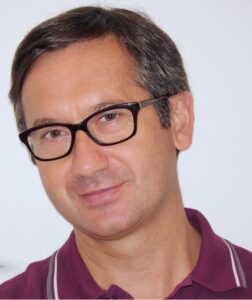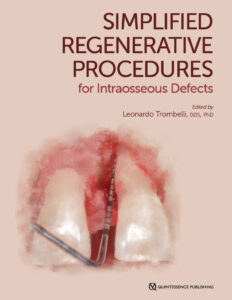Written by: Marieke Zaffron
Who here likes to watch cooking shows? Isn’t it so frustrating when your favorite contestant makes a perfect dish, then decides at the last moment that it needs something else it really doesn’t? Maybe they whip up some ice cream to add to an already balanced dessert, or they toss together a side salad to accompany their entrée. And then when time comes for judging, it’s not the dish itself they get criticized for, but the unnecessary component they decided to add. In other words, overcomplicating what could have been a simple task becomes their downfall.
Henri-Louis Bergson once said, “Man should be as eager to simplify his life as he is to complicate it,” and this holds true for so many of us, both personally and professionally. One person who loves to share this quote is Leonardo Trombelli, DDS, PhD, author of the new book Simplified Regenerative Procedures for Intraosseous Defects. A key theme of this book is the first word in its title—simplified. Clearly, more thought and planning should be put into a surgery than making a meal, but Dr Trombelli has learned that taking a simplified approach to his procedures results in more favorable outcomes.
What does it mean to simplify a procedure? Dr Trombelli explains that a procedure can be simplified when it is “characterized by more favorable conditions for the patient and/or the clinical operator.” These may include minimally invasive procedures, but there is much more to it than that. The goal of simplified treatment, Dr Trombelli explains, is to “optimize endpoints while making clinical processes and pathways easier for practitioners and students.” That is the beauty of simplifying treatment—it can then be performed by clinicians at varying skill levels, and as a result help more patients. At the University of Ferrara, where Dr Trombelli teaches and practices, these procedures are taught to students, who can learn them much more quickly and effectively than more complex procedures that might take years to master.
These may include minimally invasive procedures, but there is much more to it than that.
One example of a simplified procedure that Dr Trombelli spent years perfecting is the single-flap approach. This technique, covered extensively in his new book, involves treating a defect by raising a flap on only one aspect, such as the buccal, to preserve the vascular structures as much as possible and promote wound healing. Not only is this surgery much simpler to perform than its double-flap counterpart—many studies have shown better results with the single-flap approach than with comparable procedures. In addition, this is an approach that can be applied to many defect situations of varying severity, not only ideal scenarios.

The single-flap approach raises a flap on only one aspect, in this case the facial, to preserve vascular structures and promote wound healing.
It may seem like common sense to think that a more complex clinical situation would necessitate a more complex surgical procedure. Dr Trombelli and his team have shown that when it comes to intraosseous defects, this is simply not the case. When asked why simplified procedures with all their benefits are not widely used already, he explains, “It is just a matter of closing the gap between the introduction of a new more effective procedure and its routine adoption in daily practice.” Of course, this is not to say that anyone can pick up a scalpel and start performing simplified techniques with perfect results every time. “Simplified” doesn’t necessarily mean “simple.” However, Dr Trombelli still wishes to quash the notion that regenerative treatment of an intraosseous lesion can be performed only by highly skilled clinicians and at a very high cost to patients. His purpose in writing Simplified Regenerative Procedures is “to present techniques that may be successfully performed by the great majority of our colleagues.” After all, the more dentists who have the knowledge of treating an intraosseous defect, the more patients who can reap the benefits.
Regenerative treatment doesn’t require only highly skilled clinicians and a high cost to patients.
And what benefits indeed! The single-flap approach lends itself well to being combined with biologic regenerative devices such as enamel matrix derivative and guided tissue regeneration, and studies have shown decreased recession and probing depths as well as reduced pain and morbidity with this approach. In addition, many nonsurgical procedures—by definition simplified—can be chosen for certain situations. Regardless of whether surgery is performed or not, simplified procedures provide advantages for patients and clinicians alike: These protocols take less time to perform than more complex techniques, they are less expensive, they allow the patient to return to their normal activities sooner than with more serious surgeries, and they frequently allow the final esthetics to mimic the patient’s original esthetics without too dramatic of a change.

The single-flap approach has shown very positive patient outcomes when compared with alternatives such as a double-flap approach.
We could all use a bit of simplification in our lives. For some people, that may mean keeping a dish classic or not overthinking the next low-stakes work task requested by a coworker. For Dr Trombelli, it means developing and refining techniques—surgical and nonsurgical alike—that his students and colleagues can use to treat the maximum number of patients with the greatest success. If you’re a periodontist, then for you it could mean learning about these procedures and applying them in your own practice. Intraosseous defects may seem intimidating, but even what seems like a complex problem may have a simplified solution.
Preview the first chapter of Dr Trombelli’s new book here.
 Leonardo Trombelli, DDS, PhD, is the chair of the Periodontology Department at the University of Ferrara in Ferrara, Italy. He was Dean of the University of Ferrara Dental School from 2013 to 2018 and President of the Dental School from 2014 to 2016. Dr Trombelli is also a Past President of the Italian Society of Osseointegration and an Active Member of the Italian Society of Periodontology, the Italian Academy of Osseointegration, and the International Association for Dental Research. He serves as editorial board member for the Journal of Clinical Periodontology and Journal of Dental Research, and he is also a member of the peer-review panel for the Journal of Periodontology. Dr Trombelli also maintains a private practice limited to periodontology and oral surgery.
Leonardo Trombelli, DDS, PhD, is the chair of the Periodontology Department at the University of Ferrara in Ferrara, Italy. He was Dean of the University of Ferrara Dental School from 2013 to 2018 and President of the Dental School from 2014 to 2016. Dr Trombelli is also a Past President of the Italian Society of Osseointegration and an Active Member of the Italian Society of Periodontology, the Italian Academy of Osseointegration, and the International Association for Dental Research. He serves as editorial board member for the Journal of Clinical Periodontology and Journal of Dental Research, and he is also a member of the peer-review panel for the Journal of Periodontology. Dr Trombelli also maintains a private practice limited to periodontology and oral surgery.
 Simplified Regenerative Procedures for Intraosseous Defects
Simplified Regenerative Procedures for Intraosseous Defects
Leonardo Trombelli
Despite decades of well-established nonsurgical and surgical protocols and techniques, the treatment of deep intraosseous lesions still represents a challenge for clinicians. Therefore, the purpose of this textbook is to present simplified procedures that can be used to treat even the most difficult clinical scenarios. Both surgical and nonsurgical regenerative treatment options are presented and discussed in great detail, including types of instruments and regenerative materials to use, patient and defect evaluation, and step-by-stop protocols for various evidence-based procedures. Detailed clinical photographs and radiographs accompany each discussion to demonstrate the ideal initial situation for each method and the impressive results that can be achieved by following it, and many of the surgical sections also feature video content of procedures on real patients. A significant portion of the book is devoted to the single-flap approach, a technique developed and refined by the authors over many years to simplify surgical treatment while providing the best results for the patient. Both students and experienced professionals will find this atlas a welcome reference when encountering periodontally involved teeth.
152 pp; 524 illus; 23 videos; ©2020; ISBN 978-0-86715-945-5 (B9455); US $89
Contents
1. Introduction
2. Fundamentals in Periodontal Regeneration
3. Nonsurgical Treatment of Intraosseous Defects
4. Simplified Surgical Regenerative Procedures: The Single-Flap Approach
